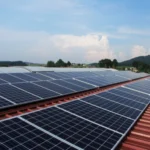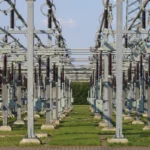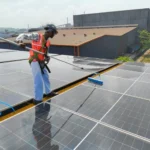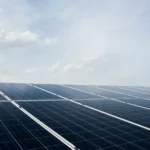How Are Solar PV Modules Made? Complete Guide to the Manufacturing Process
How Are Solar PV Modules Made? Complete Guide to the Manufacturing Process
To make a Solar PV Module, solar cells are joined physically and electrically.
Components of Solar PV Module:
- Glass
- Encapsulant
- Module frame
- Interconnectors
Steps for fabrication of Solar PV Modules:
- Cell sorting
- Contact Soldering
- Series interconnection of cells
- Preparing lamination assembly
- Laminate curing and polymerization
- Module framing & external connections
- Module I-V characterization
The first step is of sorting the solar cells (solar cells are tested and cells from same group are sorted). After sorting of cells, metal contacts are soldered in the form of metal strips, on the front side of the cells. The process of making metal contacts is known as tabbing. After this, cells are connected in series, this process is called stringing.
The above mentioned process can be done both manually and by automated technology. After stringing, stack of connected cells, glass, laminates and tedlar is prepared. After this process, the stack is kept in a machine called laminator. This process is called lamination. After the process of lamination, curing is done, where module is heated. During curing process, the polymerization of EVA occurs (formation of crosslink of chemical bonds). This process of polymerization makes the EVA sheet compact and provides strength and durability for long term. After this process modules are farmed using aluminum frames.
A plastic box containing electrical points for external electrical connection is added at the rear side of module which is called junction box. This junction box also contains bypass diodes. At the end, modules are characterized for their IV curve and power output.
Suggested Articles

Solar for Commercial Buildings in India: Costs, Benefits & ROI Explained
Solar for commercial buildings in India is becoming the smartest way to cut electricity bills and increase energy independence. This guide explains system costs, benefits, ROI, and how solar power helps offices, malls, hotels, and commercial complexes become more sustainable and profitable.

Solar Energy Gadgets in India: 9 Cool Devices to Explore
Explore 9 innovative solar-powered gadgets in India that make daily life more sustainable, energy-efficient, and eco-friendly.

Haryana’s GEOA 2025: A Boost for Captive Solar Plants and Wind Energy Developers
Haryana’s GEOA 2025 paves the way for growth in captive wind and solar energy projects with investor-friendly reforms.

Monitoring Services for Solar Plants by Smart Roof Solar to Maximize Performance and Efficiency
Smart Roof Solar provides advanced monitoring services for solar plants to ensure maximum performance and efficiency. With real-time data tracking and intelligent analytics, our monitoring solutions help detect issues early, reduce downtime, and enhance the overall energy yield of your solar system.

Solar Net Metering in Industrial Units: Opportunities and Risks
Solar net metering can help factories save on energy costs, but there are key pitfalls to consider. Learn the challenges and best practices for industrial adoption

How Quickly Can Solar Panels Pay for Themselves? Payback Period Explained
Learn how the solar panel payback period works, factors that affect ROI, and how soon you can recover your solar investment.

Solar Installation Cost in Haryana: Pricing, Savings & Subsidy Guide
Solar installation cost in Haryana varies by system size, components, and subsidy eligibility. This guide explains per-kW pricing, government incentives, and how much owners can save with rooftop solar in 2025, helping you choose the right system at the right budget.

Renewable Energy Hits New Heights: 440 GW Capacity in 2023
Learn how global renewable energy capacity is set to surpass 440 GW in 2023, marking record growth and a major shift toward clean, sustainable power.